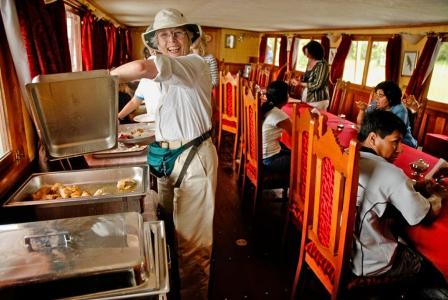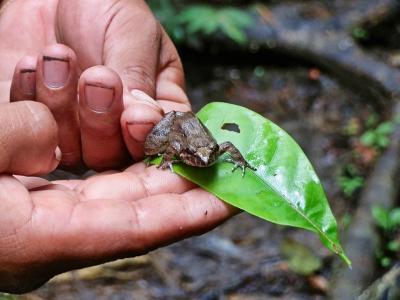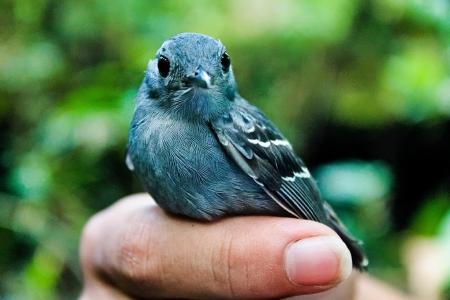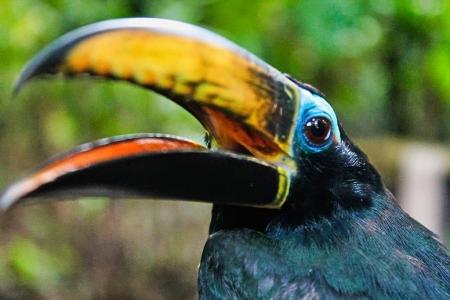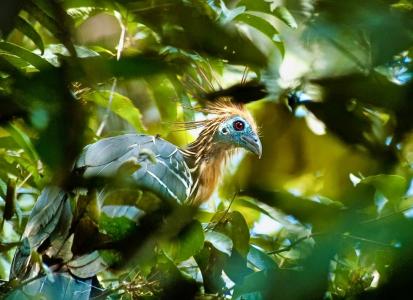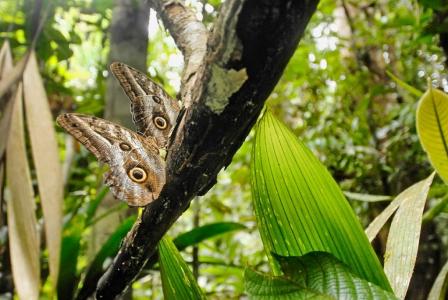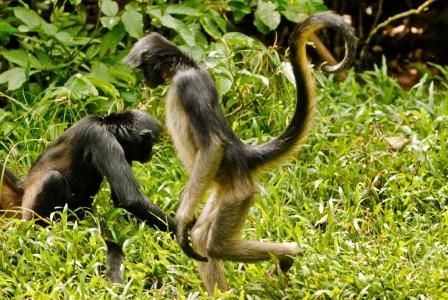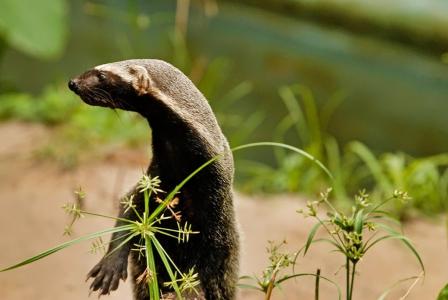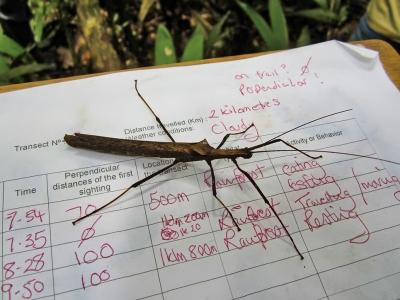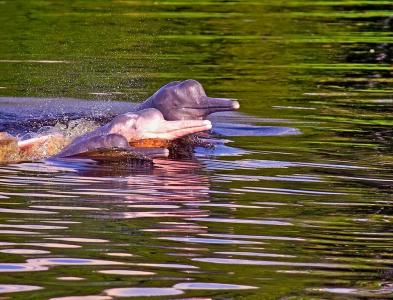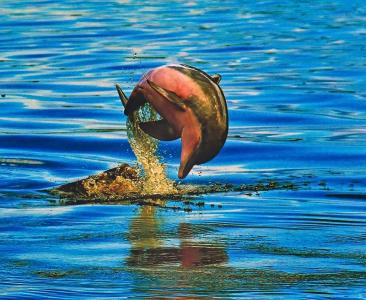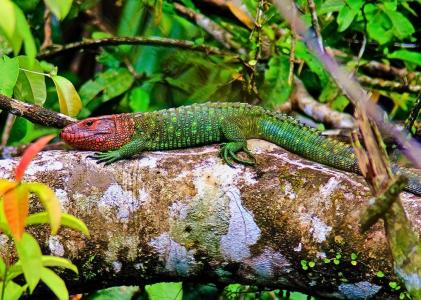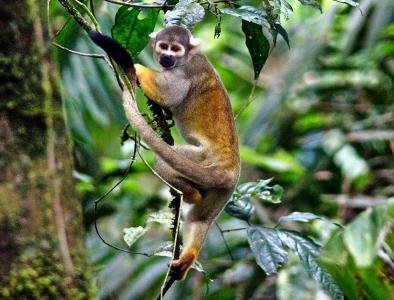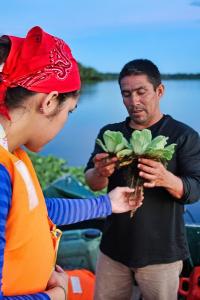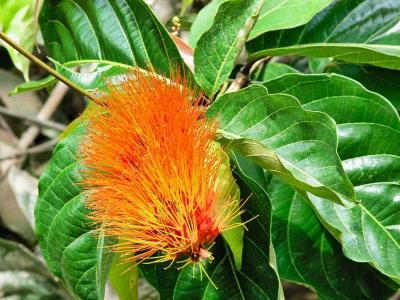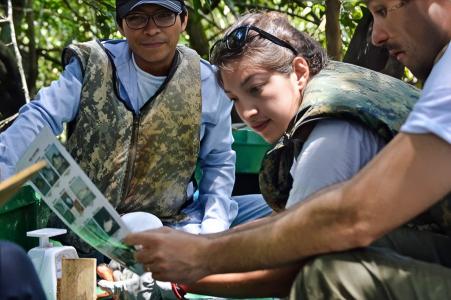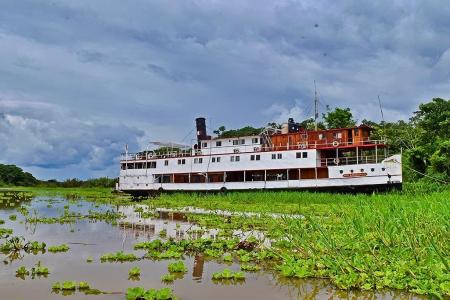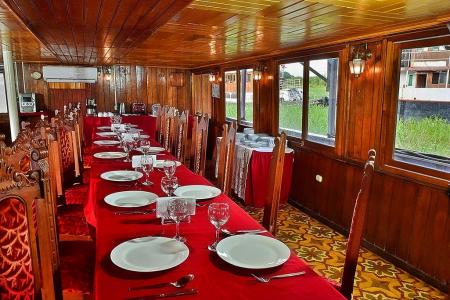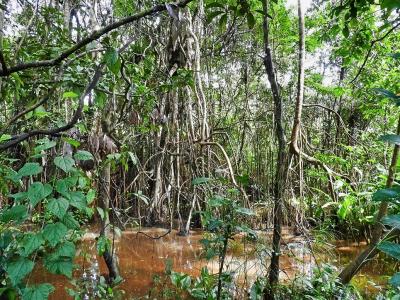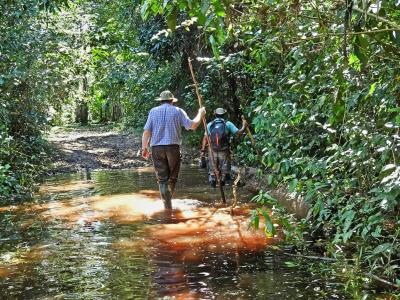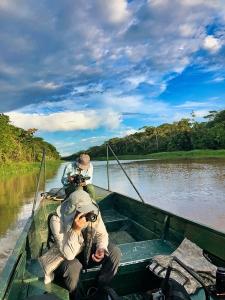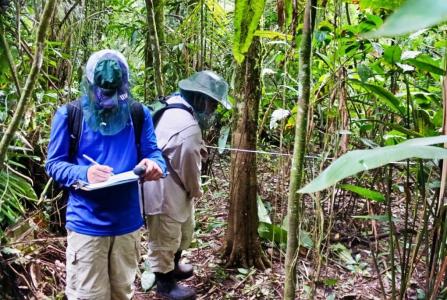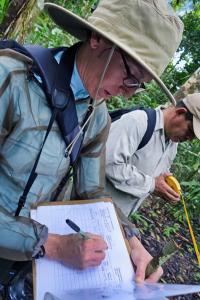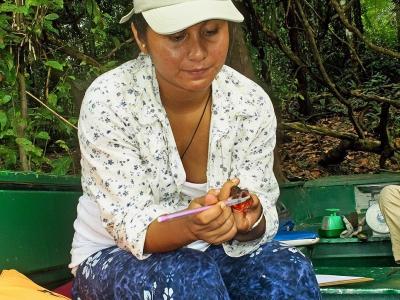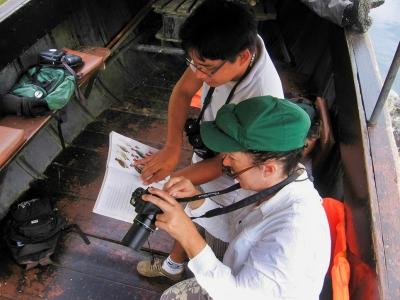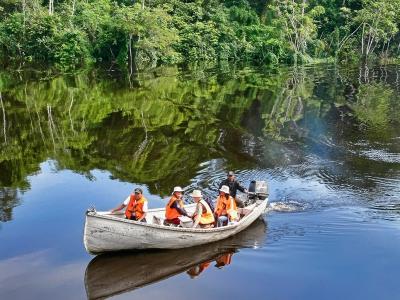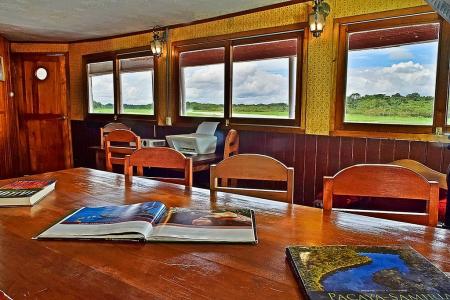Please read the following information carefully before leaving for your expedition.
Amazon Riverboat Exploration
Expedition Briefing
Quick Navigation: COVID-19 Safety | The Research | Research Aims | How You Will Help | Life in the Field | Accommodations and Food | Project Conditions | Essential Eligibility Requirements | Health and Safety | Project Risks and Precautions | Travel Planning | Additional Resources
Click on the images to view full size!
COVID-19 Safety
You are strongly encouraged to test for COVID-19 before traveling to your expedition, particularly if you are experiencing symptoms. Do not travel if you have tested positive, and call Earthwatch right away for the next steps. Please see earthwatch.org/covid-19 for more information.
The Research
The Yarapa River, which is situated between Peru’s Pacaya-Samiria National Reserve and the Tamshiyacu-Tahuayo Community Reserve, is home to a vast array of wildlife, from pink river dolphins and caimans in the waters to monkeys and extraordinary birds in the canopy. However, recent climate fluctuations characterized by successive intensive floods and droughts are impacting the aquatic, terrestrial, and arboreal species in the flooded forests, which is, in turn, impacting the local people.
Droughts cause decreases in fish, dolphin, caiman, and wading bird populations, and intense floods cause die-offs of ground-dwelling terrestrial mammals, such as peccaries, deer, large rodents, and edentates (Bodmer et al., 2018). Long-term data sets collected by this project and ongoing data collection are helping to show how community-based approaches conserve biodiversity in the face of these climatic fluctuations and help the livelihoods of indigenous people.
Since 2006, the Earthwatch-supported Amazon Riverboat Exploration project has worked to set up long-term programs to conserve biodiversity and to develop community-based conservation strategies to safeguard wildlife (Bodmer & Puertas 2007). We work together with the local people because they are the true guardians of the forest, and the information provided by our research can help them make appropriate decisions on how best to save the Amazon (Bodmer et al., 2020).
Community-based conservation was initiated by the project in the 1980s when it helped set up the first community reserve in the Peruvian Amazon, the Tamshiyacu-Tahuayo Community Reserve, which was used as a model to set new reserves and manage national reserves and Indigenous territories. Today, regional community reserves, community co-managed national reserves, and Indigenous territories make up 160,000 km2 or half of the region of Loreto. Wildlife research was fundamental in setting up sustainable use and management in these community areas and continues to validate this successful conservation strategy.
However, new threats are on the horizon. As part of a plan to modernize the infrastructure network between the Atlantic and the Pacific oceans, a Mega Hydrovia project will be implemented to make Amazonian rivers navigable year-round. To achieve this, they will dredge shallow points on the Ucayali, Marañon, and Huallaga Rivers to deepen them. The proposed dredging will likely change the water level of the rivers and impact wildlife and people, but there has been no scientific analysis to determine what those impacts will be. Using a Matrix model and Earthwatch research, this project aims to predict the possible impacts of dredging if water levels are changed (Bodmer et al. 2019).
Even the most up-to-date conservation strategies become obsolete each year as new challenges emerge. Thanks to consistent year-round monitoring conducted with the support of Earthwatch volunteers, these challenges can be identified and responded to as they happen.
Research Aims
The overarching goal of this project is to help conserve the Peruvian Amazon through field research that provides the scientific basis for biodiversity conservation. The data collected will help inform stakeholders and decision-makers on sustainable resource use, community-based conservation, impacts of climate change, the Mega Hydrovia project, and wildlife trade and recovery of endangered species.
This project aims to gather the data necessary to develop dynamic community-based conservation and sustainable use strategies that confront the current threats from climate change. Our climate work is focused on collecting wildlife monitoring data to examine how climate change is impacting wildlife populations. These data will also reveal how these fluctuations are changing the livelihoods of indigenous people and examine mitigation strategies that use community management and economic incentives.
Data will be collected to evaluate the sustainable use of wildlife by local people. Climate change and development projects can change ecosystem dynamics, shifting the goalposts for sustainable use. We will collect data on adaptations to changes in resource populations, including bushmeat and fish, to determine what sustainable use will look like in upland and flooded forest ecosystems. The sustainability research will also give insights into how stakeholders can best facilitate the recovery of endangered species, including giant river otters, black caiman, jaguars, and large-bodied primates.
The Indigenous people in Loreto are the major force behind the expansion of community-based conservation (Mayor & Bodmer 2009), which includes sustainable resource use of wildlife and wildlife products (Bodmer and Robinson 2004). Field-based research has been fundamental in providing the scientific base for sustainable wildlife use. Continued research will support community-based conservation and sustainable use programs and help keep up the momentum of the conservation movement in Loreto.
How You Will Help
The research results from this project have been used to scientifically demonstrate the sustainability of wildmeat hunting, fishing, and native palm fruit harvests. Local communities, NGOs, and governments use the research results as a basis for management plans in the Peruvian Amazon. The project has long-term quantitative data sets spanning more than three decades that are used to analyze the impacts of climate change on vertebrate fauna, and results are used to demonstrate the need for climate change action. The Peruvian Amazon is a carbon sink largely due to the community-based conservation happening in over 60% of Loreto. Results from the project’s research show how the Indigenous people are conserving intact forests with complete biodiversity through traditional resource use practices refined by scientific evidence.
MONITORING WILDLIFE POPULATIONS
As an Earthwatch volunteer, you’ll help the research staff survey animals, determine the size and composition of animal groups, determine distances to the animals, record information on datasheets, and weigh and measure animals. You’ll also visit community-based conservation plans in local indigenous villages.
The overarching research questions are: What are the populations of aquatic, terrestrial and arboreal species and how do animal populations change from climate change, dredging and community conservation, and sustainable use? You will help survey a variety of species that include river dolphins, wading & aquatic birds, fishing bats (Noctilio leporinus), fish, caimans, frogs, large felids, giant river otters (Pteronura brasiliensis), ungulates and large rodents, macaws, primates, and game birds. Population trends of these species will be correlated with water level data, which are categorized into normal, extreme drought, and intensive flood conditions (Cook Espinoza et al., 2013).
METHODS
Densities and abundances of species assemblages will be estimated annually in the Yarapa and Tahuayo River basins of the Tamshiyacu-Tahuayo community reserve. Methods will differ between species assemblages, including distance sampling, fixed width, line transects, catch-per-unit effort, point counts, age structure, and camera traps (Buckland et al. 2004).
The pink river dolphin (Inia geoffrensis) and the grey river dolphin (Sotalia fluviatilis) are indicator species for the aquatic ecosystem. Dolphin surveys are conducted in lakes, channels and rivers and will involve visual surveys, side-scan sonar surveys, and listening for dolphin echolocation signals through underwater microphones or hydrophones.
Macaws, parrots, and parakeets eat fruits and seeds and are used as general indicators of terrestrial forests. Fifteen-minute point counts along the river, streams, and lakes are used to estimate the abundance of these colorful birds.
Shoreline birds are indicators of the aquatic ecosystem, especially regarding fish production. Common species include herons, cormorants, egrets, ducks, terns, jacanas, screamers, hawks, osprey, and kingfishers, among others. Shoreline transects conducted from aluminum boats and canoes record the number of birds per kilometer of shoreline.
Fish populations are surveyed to determine the impact of climate change on this important resource for local people. Surveys focus on species commonly used by people, are conducted using gill nets and hook-and-line fishing and are compared with abundance observations employing side-scan sonar.
Terrestrial mammals and game birds are surveyed to examine the impact of climate change on wild meat species. Mammalian groups include species of primates, ungulates, rodents, carnivores, edentates, and marsupials. Game birds include guans, curassow, tinamous, and trumpeters. Surveys are done on foot using trails of 2–3 kilometers.
Camera traps are better at surveying the secretive ground-dwelling species than terrestrial transects such as jaguars (Panthera onca), pumas (Puma concolor), tapirs (Tapirus terrestris), peccaries, red brocket deer (Mazama americana), anteaters and large rodents and nocturnal species such as opossums, armadillos, ocelots (Leopardus pardalis) and pacas (Cuniculus paca). Digital camera traps with motion sensors are used to "capture" these terrestrial species to assess their presence and abundance.
Caiman surveys evaluate caiman populations' status to study climate change's impacts. Black caiman (Melanosuchus niger), Common or Spectacled Caiman (Caiman cocodrilos) and Smooth Fronted or Dwarf Caiman (Paleosuchus trigonatus) are surveyed at night using spotlights along shore-line transects.
Monitoring fishing bats is done by visual and acoustic count using a bat box and carried out at night.
Frog surveys will take place on the many “floating meadows” along the region's rivers, lakes, and channels. These floating mats of vegetation provide habitat for a rich array of wildlife-including frogs-but when they break free from where they are anchored, they also become rafts and important vectors of dispersal for those on board.
The expedition's results will be shared with local community members near the end of each team, providing them with important information for their management and conservation strategies.
Life in the Field
On research days, the team will split into groups of two to six people. We will do most activities daily, so you can participate in more than one survey and rotate tasks between days. A Peruvian field biologist and a local field assistant will accompany each group. At the end of the field day, you will help enter the data collected.
DAILY ACTIVITIES
Weather and research needs can lead to changes in the daily schedule. We appreciate your cooperation and understanding.
All teams will help monitor dolphins, macaws, primates, terrestrial mammals, game birds, caimans, fish, wading birds, frogs, and fishing bats.
During the expedition, in addition to being trained on collecting and recording data in the field, you will learn how the data you’re collecting will help conserve the Amazonian rainforests. Project staff members will give informal lectures and lead practice exercises and question-and-answer periods on topics that may include the biodiversity, geography, and ecology of the Amazon region; history of the Amazon region and the research site; population ecology of Amazonian wildlife; community-based conservation, impact of recent climate change, potential impacts of planned dredging, determining sustainable use of resources, and the importance of monitoring in protected areas of the Amazon region; socioeconomics of wildlife use in Loreto; local certification programs; and the future of the Amazon forests.
At the site, the surveys will run every day. You’ll choose what surveys to participate in the next day at the 8:00 p.m. briefings. Early morning macaw and wading bird censuses are followed by breakfast. Terrestrial forest transects, dolphin, and fish censuses will depart after breakfast and return to the boat for lunch. Afternoon surveys depart after the lunch siesta. Fishing bats are done at dusk before dinner. After dinner, there will be an evening briefing followed by caiman censuses.
During your free time, you can relax on the boat, enjoying the library and other spaces. Upon request, the crew may take you on short aluminum-canoe excursions.
ITINERARY
- Day 1: Rendezvous: Arrive in Iquitos; Visit Historic Boat Museum and Indigenous Museum; Travel 2 hours on a chartered bus to the town of Omaguas, then 1 hour in a boat. Board the research boat, Team dinner, introductions, and safety briefing.
- Day 2: Wildlife observations from the Research Station top deck. Afternoon research surveys
- Days 3–8*: Research days (see example of a possible itinerary below)
- Day 8*: Volunteers on 8-day teams will travel back to Omaguas and take a chartered bus to Iquitos, marking the end of the expedition.
- Days 9–10 Research days
- Day 11: Return to Omaguas and take a chartered bus to Iquitos. End of expedition
Example of your Day 3–8 schedule may look like (Days 9–10 will consist of similar research activities for those signed up for 11-day teams). Teams will be split into groups to complete tasks with overlapping time frames:
Day 3
- 6-8:00 a.m. Breakfast
- 7:00 a.m.–12:00 p.m. Transect
- 8:30 a.m.–1:00 p.m. Dolphins
- 1–2:00 p.m. Lunch
- 3–6:00 p.m. Fish
- 4–6:00 p.m. Shorebirds
- 7–8:00 p.m. Dinner and Briefing
- 8–10:00 p.m. Bats
- 8–10:00 p.m. Frogs
Day 4
- 6–8:00 a.m. Breakfast
- 7:00 a.m.–12:00 noon Transect
- 8:30 a.m.–1:00 p.m. Dolphins
- 1–2:00 p.m. Lunch
- 3–6:00 p.m. Fish
- 4–6:00 p.m. Macaws
- 7–8:00 p.m. Dinner and Briefing
- 8–10:00 p.m. Frogs
- 8–10:00 p.m. Caimans
Day 5
- 6–8:00 a.m. Breakfast
- 7–10:00 a.m. Canoe Shorebirds
- 8:30–1:00 p.m. Lizards
- 1–2:00 p.m. Lunch
- 3–6:00 p.m. Visit Village of Villa Belen
- 7–8:00 p.m. Dinner
- 8–10:00 p.m. Caimans
- 8–10:00 p.m. Bats
Day 6
- 6–8:00 a.m. Breakfast
- 7–10:00 a.m. Canoe Shorebirds Group 2
- 8:30 a.m.–1:00 p.m. Lizards
- 1–2:00 p.m. Lunch
- 2:30–3:30 p.m. Camera Traps
- 3:30–6:00 p.m. Fish
- 3:30–6:00 p.m. Dolphins
- 7–8:00 p.m. Dinner and Briefing
- 8–10:00 p.m. Bats
- 8–10:00 p.m. frogs
Day 7
- 6:30–8:00 a.m. Breakfast
- 10:00 a.m.–1:00 p.m. Conservation talk
- 1–2:00 p.m. Lunch
- 2–6:00 p.m. visit Jaldar village
- 7–8:00 p.m. Dinner and briefing
Day 8
- 6:30–8:00 a.m. Breakfast
- 8–11:00 a.m. Fish
- 8–11:00 a.m. Dolphins
- 12:00 noon–1:00 p.m. Lunch
- Depart
MONEY MATTERS
LOCAL CURRENCY: Peruvian Sol
PERSONAL FUNDS: It is recommended to convert $100–200 USD (or equivalent in another currency) to soles before beginning your expedition for personal expenditures.
Accommodations and Food
* Please note that not every expedition has couples or single accommodations available. Please call or email Earthwatch to check availability before reserving your space(s) on the team.
ON BOARD THE RESEARCH BOATS
For the duration of the expedition, teams will stay on the Rio Amazonas, a large, authentic boat from the days of early steam navigation on the Amazon, all restored to conditions near their original designs. The Rio Amazonas is 44 meters long and nine meters wide and was once one of the largest rubber transport boats on the Peruvian Amazon. She was built in Scotland in 1899 as a rubber transport steamship and, in the mid-1900s, transitioned into a cargo and passenger ship and regularly navigated the 2,000-mile route from Iquitos to Belem at the mouth of the Amazon. In the early 1980s, she became a tourist boat, and it was restored in 2012 by the Historic Boat Museum in Iquitos.
SLEEPING
The Rio Amazonas has comfortable accommodations in shared and single-occupancy cabins. If you would like to request a single, please notify Earthwatch. All cabins have single beds (no bunk or double beds), air-conditioning using a solar system, a desk, and a wardrobe. Cabins and toilets are cleaned daily. Showers have hot solar water. Linens are provided, bedding is changed for you, and laundry is done regularly (usually every couple of days). Laundry is also available for personal items for a small tip. It is washed in a communal space, so labeling your clothes is helpful if you use this service.
* Earthwatch will respectfully and without judgment honor each person’s assertion of gender identity. For both teen and adult teams, where logistics dictate single-sex accommodations or other facilities, participant placements will be made in accordance with the gender identity the participant specified on their Earthwatch Participant form and/or preferences indicated in discussions with Earthwatch.
BATHROOMS
Each cabin has an attached private bathroom with a shower and a conventional toilet and sink. Towels, soap, shampoo, and toilet paper are provided, but we recommend you bring biodegradable soap and shampoo if possible.
ELECTRICITY
The cabins and the rest of the boats have 220-volt electricity provided by a recently installed solar system, which is on 24 hours. The boat has both continental European plugs and US-style plugs. If you have US-style plugs that have one prong wider than the other, these don’t fit in the boat’s outlets, and you will need an adapter. Also, you may need a voltage converter for some 110-volt US appliances, though many cameras and battery chargers can accept either voltage; please check your equipment’s requirements.
PERSONAL COMMUNICATIONS
The rendezvous site in Iquitos has mobile phone reception and ground line access, while on the boat, there is mobile phone reception and Starlink Wi-Fi.
Please note: Personal communication with outsiders is not always possible during an expedition. Earthwatch encourages volunteers to minimize outgoing calls and immerse themselves in the experience; likewise, family and friends should restrict calls to urgent messages only.
FACILITIES AND AMENITIES
We use the large, air-conditioned dining rooms for meals and lectures. Coffee and tea are free, and snacks can be purchased at the bar.
The boats have libraries with field guides and academic and classic books on the Amazon, and all boats have upper sun decks.
In addition to the main boat, we use many auxiliary boats for the field activities: several large aluminum motorized skiffs (maximum capacity: 12 people), small aluminum canoes (maximum capacity: three people), one speedboat, and one 10-meter-long rubber-boom-era launch.
FOOD AND WATER
The kitchen staff prepares breakfast, lunch, tea, and dinner, which are served by plate. Breakfast is served from 6:00 to 9:30 a.m., lunch from 1:00 to 2:00 p.m., and dinner from 7:00 to 8:00 p.m. Packed meals are provided for land-based surveys when needed.
All cooking is done with treated drinking water brought in from a licensed company. Porcelain, cutlery, and cooking materials are sanitized in a chloride solution. Uncooked foods, such as salads, are prepared using latex gloves.
TYPICAL MEALS
The following are examples of foods you may find in the field. Variety depends on availability. We appreciate your flexibility.
- Breakfast: Coffee, tea, milk, toast with jam and butter, cereal, yogurt drinks, fruit drinks, oatmeal, eggs, fruits, ham, cheese
- Lunch: Fish, beef, poultry, or pasta; salad, soup, rice, potatoes, bread and butter; dessert, juice, coffee, tea
- Tea: Tea, coffee
- Dinner: Fish, beef, poultry, or pasta; salad, soup, rice, potatoes, bread and butter; dessert, juice, coffee, tea
- Snacks: Bread, fruits, crackers, and other snacks are available at the bar area.
- Beverages: We have treated water bought from a licensed company for drinking. Fruit juices are provided, and additional drinks can be purchased at the bar.
SPECIAL DIETARY REQUIREMENTS
Please alert Earthwatch to any special dietary requirements (e.g., diabetes, lactose intolerance, nut, other food allergies, vegetarian or vegan diets) as soon as possible and note them in the space on your volunteer forms.
The food service can accommodate vegetarian and vegan diets; however, it is recommended you bring some of your favorite snacks.
Project Conditions
The following information is as accurate as possible, but please remember that conditions may change.
The Amazon is hot and humid during the day, and although it cools off at night, the humidity stays high. The climate does not vary much throughout the year.
GENERAL CONDITIONS
Please visit wunderground.com and search your project location for weather and region-specific information.
BOATING CONDITIONS
You will feel minimal movement on the docked research boats. Auxiliary boats will be used for activities for about three hours per river survey. These boats have sun canopies for use during the dolphin and fish census, which happens when the sun is intense. Canopies will not be used during early morning or night censuses. There are no toilets on the auxiliary boats, but boat drivers can stop at a beach if necessary.
The rivers are usually calm but can get choppy during storms or from wakes when boats pass. Rainfall is heaviest from December to June, so there is a higher water level in these months. From June through November, the dry season, the water level is lower, but there still may be heavy rains.
Essential Eligibility Requirements
All participants must be able to:
- Enjoy being outdoors and around water all day, in all types of weather, in the potential presence of wild animals, insects, and mold.
- Tolerate approximately 28°C (82°F) to 35°C (95°F) heat, direct sun, and high humidity levels.
- Be comfortable and maintain balance climbing in and out of small boats, walking on the large research vessel's deck, which can be slippery at times, and climbing boat stairways.
- Sit on auxiliary boats for three to six hours daily for at least four days.
- Carry personal daily supplies such as water, rain gear, and some small field equipment.
- Function without a consistent source of electricity. Solar lights are 24 hours, plugs 12 hours, and will not always run throughout the night; therefore, the project cannot accommodate electrical devices such as a C-PAP machine.
- Participants who choose to take part in terrestrial transects must be able to:
- Traverse cleared paths on dry and wet forest trails, which can be very muddy terrain at a pace of one km per hour for up to four hours per day while carrying personal supplies and small field equipment.
- Follow verbal and/or visual instructions independently or with the assistance of a companion.
- Take an active role in one’s safety by recognizing and avoiding hazards if and when they arise (including, but not limited to, those described in Earthwatch materials and safety briefings). Always comply with project staff instructions and recommended safety measures.
- Be able to effectively communicate with the staff if they are experiencing distress or need assistance.
- Be able to get along with a variety of people from different backgrounds, often in close proximity, for the duration of the team.
- Be comfortable being surrounded by a language and/or culture that is not your own.
Health and Safety
EMERGENCIES IN THE FIELD
The boat has a telephone, Wi-Fi, and short-wave radio for project and emergency use. The office in Iquitos is contacted daily.
Earthwatch has a 24-hour, 7-day-a-week emergency hotline number. Someone is always on call to respond to messages that come into our live answering service.
IMMUNIZATIONS & TRAVEL VACCINATIONS
Please be sure your routine immunizations are up to date (for example, diphtheria, pertussis, tetanus, polio, measles, mumps, rubella, and varicella) and that you have the appropriate vaccinations for your travel destination. Medical decisions are the responsibility of each volunteer and their doctor. Visit the Center for Disease Control and Prevention or the World Health Organization for guidance on immunizations.
If traveling from countries or regions where yellow fever is endemic, you must have a certificate of vaccination.
Staying up to date with your COVID-19 vaccinations, including receiving booster doses, as applicable, is strongly encouraged.
Project Risks and Precautions
TRANSPORTATION
- On the Main Boat: Wear non-slip shoes when on the deck, and always use handrails when going up and down the stairs. Do not sit on rails, dangle feet over the deck, or enter the engine room. We have taken the following safety precautions: Life vests are readily available for all volunteers and staff. Life rings are visibly placed along railings. Fire meeting points are pointed out to all passengers and crew. The boat crew is trained in emergency procedures, and all crew members are certified by the Peruvian Coast Guard and have official maritime marine documents. The Peruvian Coast Guard inspects the boat for safety.
- On the Auxiliary Boats/Canoes: You must always wear a life vest when working from the auxiliary boats or canoes. You will always go with a boat guide in these smaller boats. You should not handle the outboard engines or enter the immediate engine area. All guides are trained in boat safety and handling. Canoes and auxiliary boats will never exceed their maximum capacity. All guides can swim and can assist volunteers in an emergency.
- Police/Coast Guard/Military Controls: The expedition may have to pass through official security controls; please do not be alarmed by these. The PI and staff will handle all controls. You should provide passport information when requested by the PI, staff, and/or officials at the controls.
- Forest Transects/Trails: Transect census walks can be physically demanding and potentially dehydrating. Please bring a minimum of one liter (approx. 33 ounces) of drinking water on the transects. Walk slowly and rest frequently if overheated. You must always wear field boots and field clothes. We also suggest using a walking stick (which you can cut in the forest) when going through muddy areas. Guides will also pace the walk-in according to the physical condition of volunteers and the terrain. You will be informed about any potentially harmful plants along the trails, especially those with thorns. Thorns will be removed and treated with a disinfectant solution and antibiotic cream. Messengers on foot will alert the boat crew in case of emergency during terrestrial transects because handheld radio signals are unreliable in the dense forest.
ANIMALS
- Handling Fish: Handling fish is entirely voluntary. Once project staff have properly secured the animals, volunteers will only handle fish, including piranha. You should wear leather gloves to handle any species of live fish. In the event of a bite, first aid will be administered, and, depending on severity, the person may be taken to the nearest clinic.
- Mosquitos: Mosquitos are most abundant inside the forest on terrestrial transects. Long-sleeved shirts, mosquito net hats, and insect repellant are the best ways to decrease annoyance.
- Snakes: In the past 20 years of the project, no venomous snake has bitten anyone. Nevertheless, harmful snakes, including fer-de-lance, bushmaster, and coral snakes, live in the area. Anti-venom is available in Iquitos and can be applied in a clinic, so the plan is to get the injured person to a clinic or hospital as soon as possible. Guides will carry extractors and pressure bandages into the field. All volunteers should wear rubber boots or snake guards when walking in the forest to protect their ankles and carefully examine any area where they walk or sit.
- Insects: Biting and/or stinging bees, wasps, bullet ants, scorpions, and spiders are all present in the research area. Team members will occasionally be bitten or stung, but these injuries are usually not very severe. If anyone develops an allergic reaction, they will be taken to the nearest clinic. If you are allergic to insects, please discuss this with your doctor and bring appropriate medication (e.g., antihistamines, at least two Epi-Pens). Insect bites can get infected, so you should treat and clean any bites. To repel insects, please wear appropriate footwear and clothing and bring insect repellent into the field. Only touch trees after first checking for dangerous insects, and carefully examine any area where you intend to sit down. Volunteers should turn off flashlights/torches during the caiman surveys if wasps are present. Anti-red-eye flashes should also be turned off on cameras, and the person handling the spotlight should wear leather gloves.
- Domestic Animals and Pets: Volunteers should not touch, pet, or handle any domestic animals at the guard posts, villages, or towns, including dogs, cats, chickens, ducks, pet primates, parrots, macaws, and other species.
CLIMATE/WEATHER
It will be hot and humid. You will need to protect yourself from the sun with appropriate clothing and sunscreen (at least 30 to 60 SPF) and drink plenty of water throughout the day to avoid dehydration. Some of the small auxiliary boats have sunshades, but the reflection off the water can still cause sunburn. After-burn cream will be available. A rehydration solution may be given to anyone who gets dehydrated. It can rain at any time of the year, so please bring light rain gear suitable for tropical climates. All volunteers should wear light, warm clothes during the early-morning macaw transects and the evening and night caiman surveys, which can be chilly.
Because of the high humidity, those using hearing aid devices may find they don’t work properly.
PERSONAL SECURITY
Always stay with a group when on the expedition. We advise against attending late-night activities in Iquitos. If you encounter a problem while away from the boat, contact the nearest police station or consulate. Local authorities will be contacted if any illegal activity occurs.
SWIMMING
Swimming is not permitted on this project.
DISTANCE FROM MEDICAL CARE
The nearest hospital is a clinic in Nauta, approximately 30 kilometers (19 miles) from the site and one hour to reach by speedboat. The hospital in Iquitos is 130 kilometers (80 miles) from the site and takes approximately 3 hours to reach. If you have a chronic condition that could require immediate medical care (e.g., heart conditions, kidney problems, severe asthma, etc.), or if you are pregnant, please discuss your participation on this expedition with your physician.
DISEASES
Diseases found in this region may include malaria, dengue fever, Zika virus, cholera, tuberculosis, filariasis, leishmaniasis, onchocerciasis, trypanosomiasis, schistosomiasis, strongyloidiasis, hepatitis, leptospirosis, chikungunya, polio, tick-borne encephalitis, plague, typhoid, and others. You can decrease your risk of most diseases by avoiding mosquito bites, wearing protective clothing and shoes, practicing good hygiene, and drinking only bottled or filtered water when appropriate. Chloroquine-resistant malaria is endemic to the Peruvian Amazon and has been frequently reported in towns such as Nauta. Rabies is present in the region and can be transmitted by stray dogs and bats. Whether you have been vaccinated or not, always avoid loose and stray dogs. The pre-exposure vaccination does not eliminate the need for post-exposure medical attention and treatment, but it does provide additional protection against the disease in the event of a delay in treatment. In addition, bites or scratches should be immediately and thoroughly washed with soap, clean water, and a topical povidone-iodine solution or ethanol. If you feel ill once you return from your trip, inform your doctor that you have recently returned from a tropical region.
For more information on these conditions and how to avoid them, please visit the US Centers for Disease Control and Prevention (cdc.gov) or the World Health Organization (who.int) websites.
RISK OF COVID-19 OR OTHER RESPIRATORY ILLNESS
Earthwatch strongly encourages you to take precautions to help protect yourself and others from common viral respiratory illnesses, including COVID-19, flu, and RSV: stay up to date with your vaccinations; wash your hands frequently; take steps to improve air quality, for example, by increasing ventilation indoors or gathering outdoors; and use preventative measures to limit the spread if you are sick.
Persons with a higher risk of severe respiratory illness should consult their healthcare provider before participating.
Travel Planning
RENDEZVOUS LOCATION
FAP Francisco Secada Vignetta International Airport (IQT) (Frequently referred to as Iquitos Airport) Iquitos, Peru
Your Earthwatch Expedition Logistics Document, which matches the current year and can be found in your MyEarthwatch Portal once you enroll, will provide specific travel planning details. Please do not book travel arrangements—such as flights—until the Expedition Logistics Document matching the current year has been published to your portal account.
ABOUT YOUR DESTINATION
Earthwatch strongly recommends that travelers investigate their destination before departure. Familiarity with the destination’s entry/exit requirements, visas, local laws, and customs can ensure smooth travel. The U.S. Department of State's Traveler’s Checklist and Destination Guides are helpful resources. For LGBTI travelers, the U.S. Department of State's LGBTI Travelers page contains many helpful tips and links.
COUNTRY AND PROJECT ENTRY REQUIREMENTS
You are responsible for reviewing and abiding by your destination's entry/exit requirements.
Entry visa requirements differ by country of origin, layover, and destination and do change unexpectedly. For this reason, please confirm your visa requirements at the time of booking and again 90 days before travel. Please apply early for your visa (we recommend starting six months before the start of your expedition). Refunds will not be made for volunteers who cancel due to not obtaining their visa in time to meet the team at the rendezvous. You can find up-to-date visa requirements at the following website: travisa.com.
If a visa is required, participants should apply for a TOURIST visa. Please note that obtaining a visa can take weeks or even months. We strongly recommend using a visa agency to expedite and simplify the process.
Resources
ARTICLES
- Bodmer, R., P. Mayor, M. Antunez, K. Chota, T. Fang, P. Puertas, M. Pittet, M. Kirkland, M. Walkey, C. Rios, P. Perez-Peña, P. Henderson, W. Bodmer, A. Bicerra, J. Zegarra and E. Docherty. 2018. Major shifts in Amazon wildlife populations from recent intensification of floods and drought. Conservation Biology. 32(2): 333-344
- Bodmer, R., P. Mayor, M. Antunez, T. Fang, K. Chota, T. Ahuanari Yuyarima, S. Flores, B. Cosgrove, N. López, O. Pizuri & P. Puertas. 2020. Wild Meat Species, Climate Change, and Indigenous Amazonians. Journal of Ethnobiology, 40: 220-235.
- Bodmer, R., P. Puertas, and T.G. Fang. 2008. Co-managing Wildlife in the Amazon and the Salvation of the Pacaya-Samiria National Reserve in Peru. In: Manfredo, M. et al (eds.). Wildlife and Society: The Science of Human Dimensions Island Press.
- Kirkland, M., C. Eisenberg, A. Bicerra, R. Bodmer and P. Mayor 2018. Sustainable wildlife extraction and the impacts of socio-economic change among the Kukama-Kukamilla people of the Pacaya-Samiria National Reserve, Peru. Oryx. DOI. 10.1017/S0030605317001922.
- Bodmer, R., T. Fang, M. Antunez, P. Puertas, K. Chota, M. Pittet, M. Kirkland, M. Walkey, C. Rios, P. Perez-Peña, P. Mayor, J. Zegarra and E. Docherty (2017). Impact of Recent Climate Fluctuations on Biodiversity and People in Flooded Forests of the Peruvian Amazon. CBD Technical Series No. 89, pp.81-90.
- Bodmer, R, Puertas, P, Henderson, P, Mayor, P, Antúnez, M, Fang, T, Chota, K, Arenas, M, Glotin, H, Trone, M, Cosgrove, B, Docherty, E and M. Walkey (2018). Modelamiento de los Consecuencias Previsibles del Dragado de los Principales Ríos Amazónicos Sobre la Fauna Silvestre y la Gente de los Bosques Inundados de Loreto, Perú. Folia Amazonica. Vol. 27 (2): 247-258. DOI: https://doi.org/10.24841/fa.v27i2.471
BOOKS
- Bodmer, R. 2014. Pacaya-Samiria: Land of Mirrors. Wust Publications. Available on board to read or purchase.
- Mayor, P., Alvarez, J. Garcia, J. and R. Bodmer. 2020. Pueblos Indígenas de la Amazonía Peruana. 2nd Ed. Available on board to read or purchase.
- Hemming, J. 2009. Tree of Rivers: The Story of the Amazon
- Grann, D. 2010. The Lost City of Z: A Tale of Deadly Obsession in the Amazon
- Lange, A. 2011. In the Amazon Jungle
- Silvius, K., Bodmer, R., and J. Fragoso. 2004. People in Nature: Wildlife Conservation in South and Central America
FIELD GUIDES
- Clements, J.F. and N. Shany. 2001. A Field Guide to the Birds of Peru.
- Schulenberg, T.S. et al. 2010. Birds of Peru.
- Kricher, J. 1999. A Neotropical Companion.
- Bernard, H. 2002. Insight Guide: Amazon Wildlife.
- Emmons, L.H. and Fea, F. 1997. Neotropical Rainforest Mammals: A Field Guide (2nd ed.).
- Bright, M. 2000. South America Revealed: A Wildlife Guide from Andes to Amazon.
PROJECT FIELD REPORT
Each Earthwatch-supported project submits a field report on past research and results. The most recent for this project is available online at https://earthwatch.org/sites/default/files/2024-03/2022_Amazon%20Riverboat%20Exploration_Field%20Report.pdf. (Reports not available for all projects.)
PROJECT-RELATED WEBSITES
- Latin American Wildlife Society (in Spanish)
- FundAmazonia
- Dr. Bodmer’s homepage
- Pacaya-Samiria National Reserve
- Museums
LITERATURE CITED
- Bodmer, R., P. Mayor, M. Antunez, T. Fang, K. Chota, T. Ahuanari Yuyarima, S. Flores, B. Cosgrove, N. López, O. Pizuri & P. Puertas. 2020. Wild Meat Species, Climate Change, and Indigenous Amazonians. Journal of Ethnobiology, 40: 220-235.
- Bodmer, R., P. Mayor, M. Antunez, K. Chota, T. Fang, P. Puertas, M. Pittet, M. Kirkland, M. Walkey, C. Rios, P. Perez-Peña, P. Henderson, W. Bodmer, A. Bicerra, J. Zegarra and E. Docherty. 2018. Major shifts in Amazon wildlife populations from recent intensification of floods and drought. Conservation Biology
- Bodmer, R.E. and P.E. Puertas. 2007. Impacts of Displacement in the Pacaya-Samiria National Reserve, Perú. En: Protected Areas and Human Displacement: A Conservation Perspective. Redford, K.H. y E. Fearn (eds). WCS Working Papers 29:29-33.
- Bodmer, R, Puertas, P, Henderson, P, Mayor, P, Antúnez, M, Fang, T, Chota, K, Arenas, M, Glotin, H, Trone, M, Cosgrove, B, Docherty, E and M. Walkey (2018). Modelamiento de los Consecuencias Previsibles del Dragado de los Principales Ríos Amazónicos Sobre la Fauna Silvestre y la Gente de los Bosques Inundados de Loreto, Perú. Folia Amazonica. Vol. 27 (2): 247-258. DOI: https://doi.org/10.24841/fa.v27i2.471
- Bodmer, R.E. and Robinson, J.G. 2004. Evaluating the sustainability of hunting in the Neotropics. In: Silvius, K., Bodmer, R. and Fragoso, J. (eds.) People in Nature: Wildlife Conservation in South and Central America, Columbia University Press, New York, 299-323.
- Mayor, P. and Bodmer, R. 2009. Pueblos Indígenas de la Amazonía Peruana. Ed. CETA, Iquitos, Peru, pp. 312, ISBN: 978-612-00-0069-4
- Espinoza JC., Ronchail J., Frappart F., Lavado W., Santini W., Guyot JL., 2013. The major floods in the Amazonas River and tributaries (Western Amazon basin) during the 1970 – 2012 period: A focus on the 2012 flood. Journal of Hydrometeorology 14: 1000-1008.
Sign up for the Earthwatch Newsletter
Be the first to know about new expeditions, stories from the field, and exciting Earthwatch news.
.
.
.


